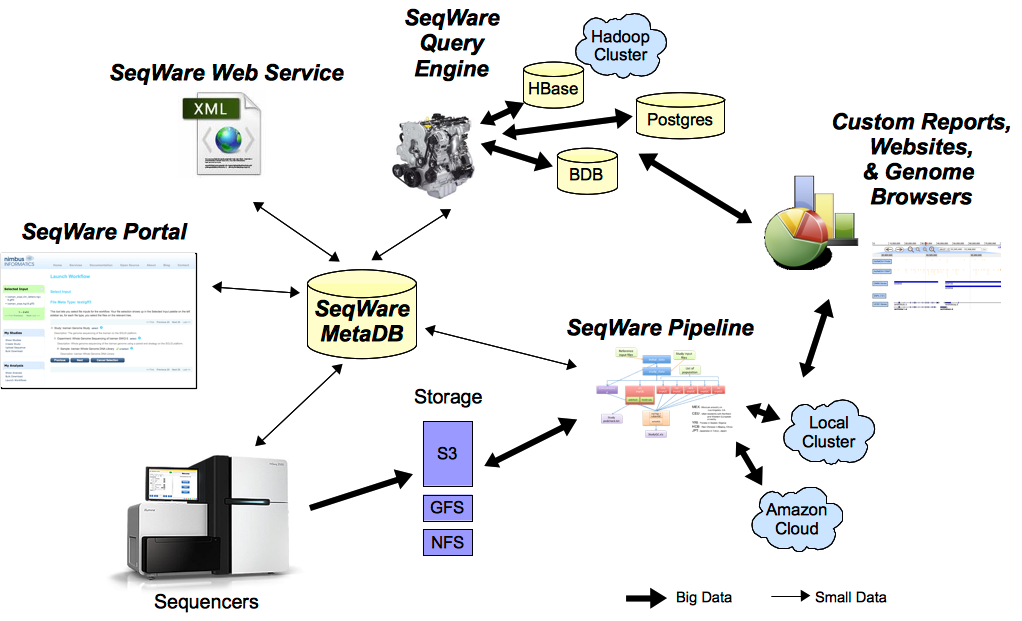Documentation
This is the core documentation for the SeqWare project, including all the various sub-projects. We wanted to create a single manual that would bring together all of our documentation since much of it is currently spread across a poorly-organized wiki. Because SeqWare is a fairly complex software stack (with some difficult-to-configure dependencies) we assume most users will start with a VM, either a local VirtualBox VM or an Amazon Machine Image (AMI) on Amazon’s cloud. See “Installation” for directions for getting the VM. While this guide is organized by logical sections that flow from one to the next you do not need to read the whole thing in order to get started. Take a look at the tutorials in the “Getting Started” section which will walk you through the core functionality such as SeqWare Pipeline.
The tutorials are divided into User, Developer, and Admin guides. These reflect the three types of users that will interact with a SeqWare install. Generally the User injects input data into SeqWare, runs workflows, and collects the results. These users also use our various command line and Portal reporting tools. The second user is a Developer that is actually responsible for the creation and testing of new workflows. Finally, the Admin installs workflows, automates the launching of workflows, and identifies failed workflows. This user is responsible for the components that allow the User and Developer to do their work and, consequently, this role is responsible for setting up and maintaining the various SeqWare components.
We recommend you follow the guides in the following order: User, Developer, then Admin guides.
Users |
Developers |
Admins |
|---|---|---|
 |
 |
 |
SeqWare Overview
SeqWare currently provides 5 main tools specifically designed to support the analysis necessary for massively parallel sequencing technologies. All tools can be used together or separately. The tutorials below will focus mainly on Pipeline with information about other projects provided as needed:
- MetaDB: provides a common database to store metadata used by all components.
- Portal: a LIMS-like web application to manage samples, record computational events, and present results back to end users.
- Pipeline: a workflow engine that is capable of wrapping and combining other tools (BFAST, BWA, SAMtools, etc) into complex pipelines, recording metadata about the analysis, and facilitates automation of pipelines based on metadata.
- Web Service: a programmatic API that lets people build new tools on top of the project
- Query Engine: a NoSQL database designed to store and query variants and other events inferred from sequence data.

SeqWare Users
There are three major roles that SeqWare users can be classified into.
- User: a user of workflows, the user injects data into the system, triggers workflows, and gets the results back once finished
- Developer: a developer of workflows, the developer makes new workflows and are typically Bioinformaticians and experts in NGS analysis techniques and tools
- Admin: an admin of the system, this is typically both a sys admin that installs and configures SeqWare components and is also responsible for installing new workflows and setting their default configurations
Depending on the size of the group these roles may be the same person, distinct people, or even distinct groups within a larger organization.
Conventions
The SeqWare documentation uses a few conventions for markup:
- Italic text introduces new terms.
-
Monospaced textis used for code snippets. - Monospaced, bold text is used for commands that should be typed literally.
- Monospaced, italic text is used for text that should be replaced with user-supplied values.
The documentation also contains quite a few blocks of code snippets. These are marked up like this:
class Lorem::Ipsum
def dolor
[ :foo, "sit amet, consectetur adipisicing elit", 123 ]
end
endBash shell input/output are marked up in a similar way. Note that the prompt is always included, but should never be typed. Here’s an example:
some-dir% echo "hello" && cd other-dir hello other-dir%